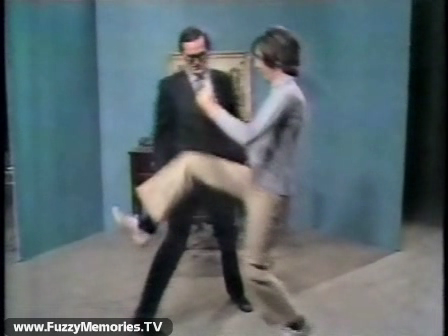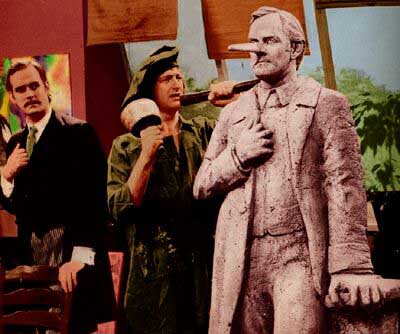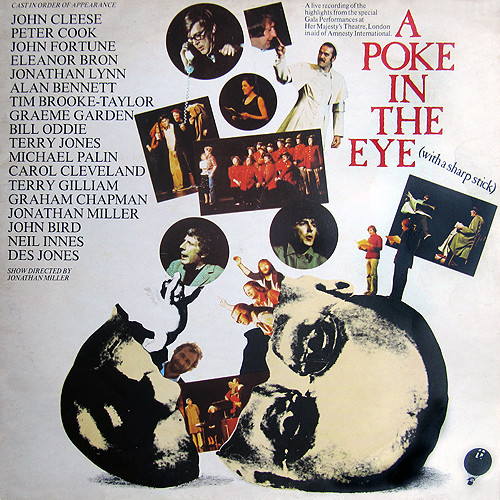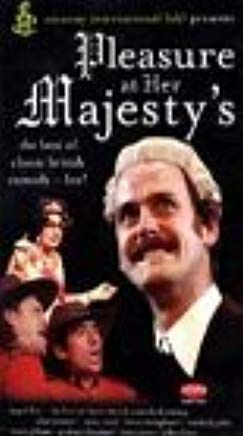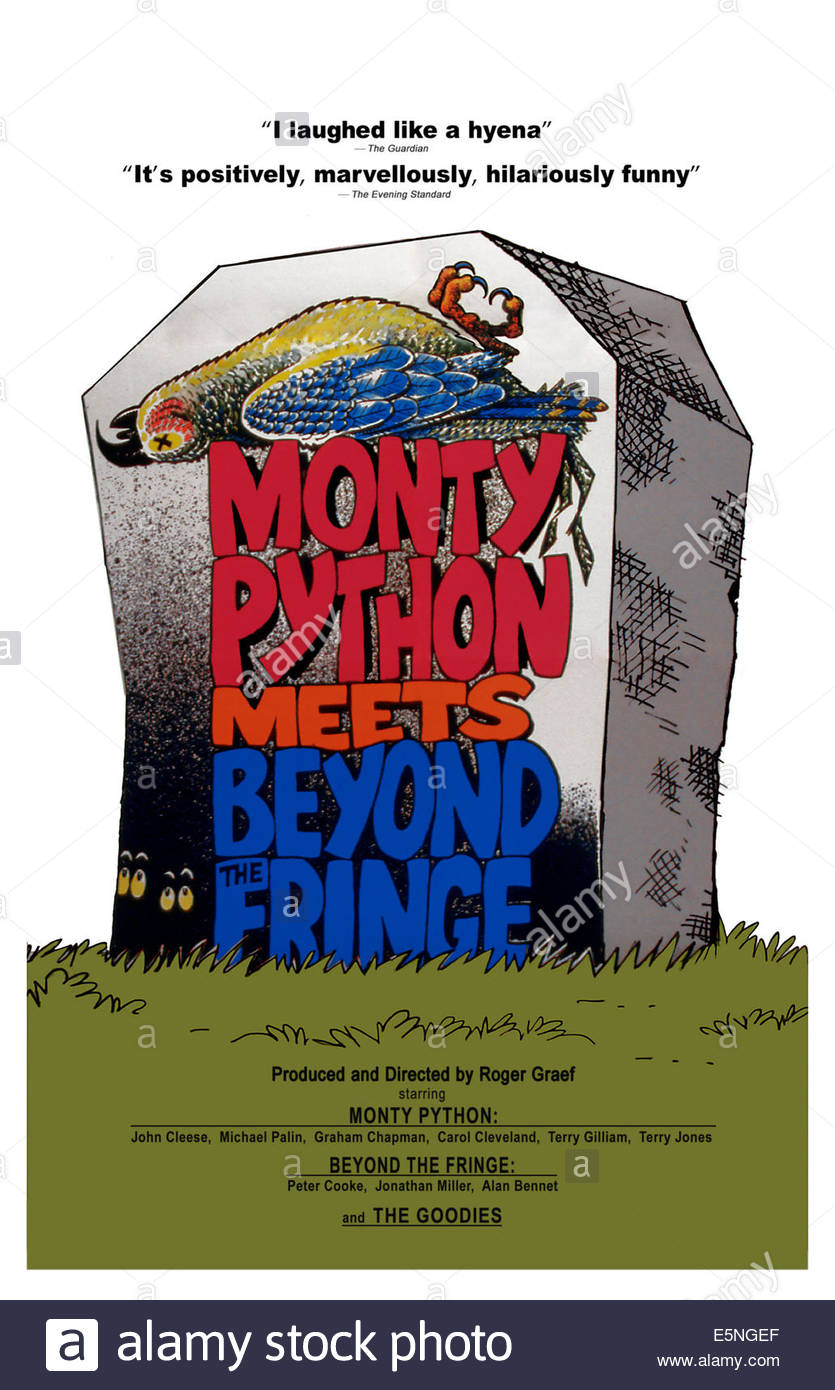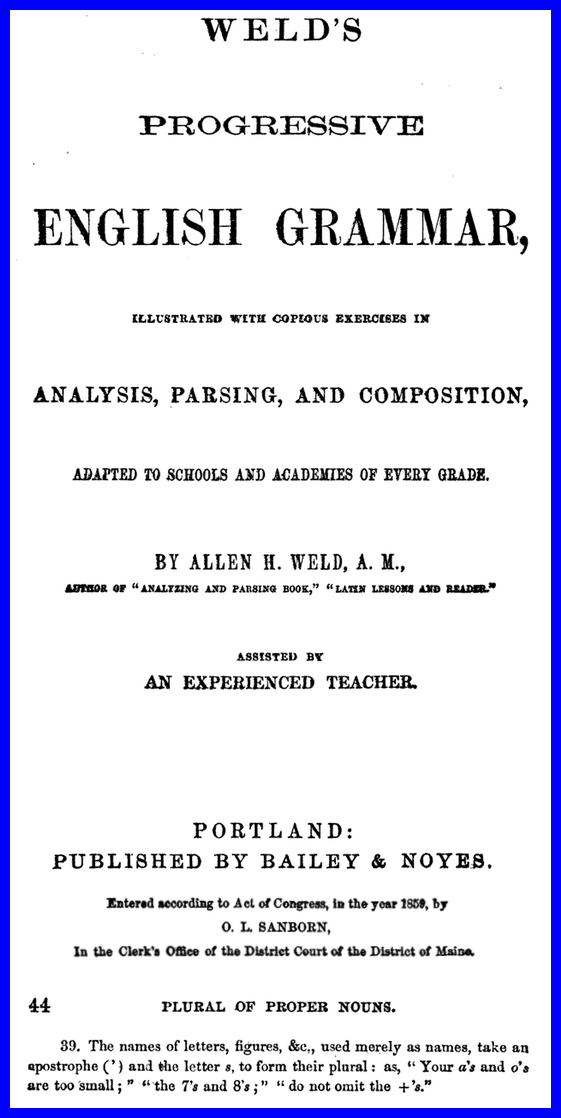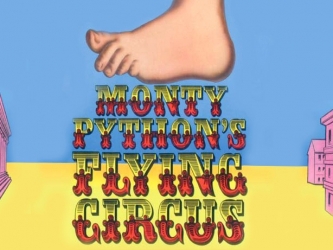
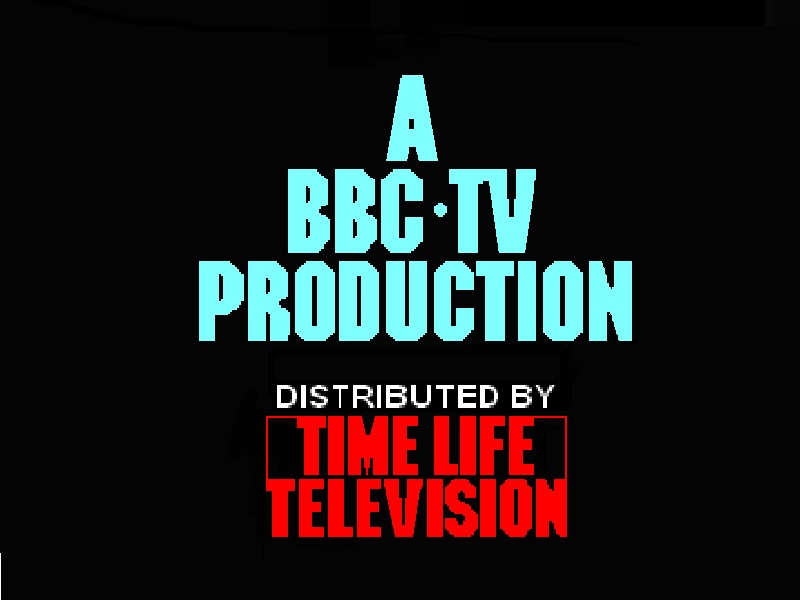
There’s Still Stuff Missing!
|
I just learned that many of my complaints below may now be outdated.
Please take a look at these four items:
Robert Ham, “The Unknown Hero Who Saved Monty Python’s Flying Circus from Being Erased,” Paste Magazine, 2 June 2016
There are problems with this story. How could Jones and his fellow Pythons possibly have smuggled the tapes out of the BBC vault, made VHS copies (in 1971???), and then presumably smuggled them back in to be wiped? VHS was not invented until 1976 and was not put on the market until 1977, and the copies that have come down to us are not derived from VHS at all. Breaking in to the BBC vaults was about as likely as breaking in to the Pentagon, or breaking in to Fort Knox. Quads are not cassettes. There are too, too, too many problems with this article. If there is any truth to this article, then all we can derive from it is that someone prevented the tapes from being wiped, possibly by paying the BBC to purchase blank tapes so that erasures would not be needed. “Monty Python’s 50th Anniversary Details,” British Comedy Guide, 26 June 2019; How are the censored bits being put back in? To the best of my knowledge, those masters no longer exist. Are these sketches being restored from multiple sources? People at home did record the program on VHS and VCord, and there were also 16mm b&w kinescopes, presumably for armed forces overseas. My best guess is that, if these sketches are being restored, then they probably derive from the kinescopes and are then being colorized to match the home recordings. One “From the Monty Python Archive: ‘DéJà Vu’ Resurrected,” Monty Python, 6 May 2019 Is this the master quad from 1970, or is it a copy? Isn’t it nice to see and hear the color bars and countdown leader? I wish those would be included in the “Monty Python’s 50th Anniversary Plans,” Steve Hoffman Music Forums, discussion started 26 June 2019 This is an online discussion that raises more questions than it answers.
Too many mysteries.
Nonetheless, my fingers are crossed.
|
Okay, you ask, why are we interested only in the Time Life editions? Here’s the story. The BBC had censored several episodes of Monty Python’s Flying Circus when they were originally broadcast in 1969 through 1974. But when PBS, through Time Life, licensed the US broadcast rights, the BBC mistakenly sent over, for the most part, the uncensored versions!
Monty Python’s Flying Circus first appeared in the US in 1974, shortly after the group had officially disbanded
and just as the final season was approaching its close in Great Britain.
My friends and I would watch these episodes religiously.
Then it was in late 1980 that Time Life’s license expired.
We all suffered withdrawal as we went Pythonless for several years.
Then, at long last, another outfit, Devillier Donegan, released the series beginning in the autumn of 1983.
We were appalled.
Some of our favorite sketches were chopped to pieces, revoiced, or deleted altogether.
You see, Devillier Donegan had received the standard BBC censored versions.
Of course, my friends and I all thought that the folks at Devillier Donegan were the culprits,
and we fully expected the uncut episodes to be broadcast once again after Devillier Donegan’s license expired.
We were to be sorely disappointed.
We did not realize that the masters of the uncensored episodes had been destroyed by that time.
Here are two examples, which thank heaven have been documented.
Please take a look at
http://home.mira.net/~kirseval/python24/.
Yes, those were complete when Time Life had the license, and I remember them distinctly.
Once Devillier Donegan got the license, the “Cartoon Religions” animation was extremely choppy, to de-emphasize the crucifixions.
Nowadays, on the home-video editions, the new editors decided that they did not like the choppiness,
and so they simply truncated the sketch altogether, cutting it off long before its proper ending.
Here is the uncut opening
of that episode from the 16mm kinescope.
It has a few lines of dialogue deleted from all current broadcast and video copies:
|
Note the tearing at the bottom of the image.
This kinescope derived from a ¾" U-Matic tape.
Note also the framing problem, with the frame line at the top.
It doesn’t seem that the transfer was out of frame;
it seems that this was a problem in the original kinescope filming,
but it’s hard to know for sure, especially when all we can see is this YouTube clip.
Out of curiosity, I downloaded this clip, opened it in VLC Media Player, and then watched it frame by frame. I wanted to know if this originated from a PAL source (1 film frame = 1 video frame) or an NTSC source (blended video frames or every fifth frame duplicated). It looks to me like it was from a PAL source, which is good, very good indeed. |
Fortunately, that 16mm kinescope allowed the BBC techies to do a colorization to restore somewhat the look of the original “Cartoon Religions.” You have the beginning on DVD at home. Here, at last, is the ending:
Another example was, I think, my favorite sketch of all.
But when Devillier Donegan picked up the series, that entire sketch was missing,
and instead what we saw was a caption that read something like
“Tonight’s episode will begin straight away with the credits.”
That was followed by another caption that read something like, “No you didn’t.
You started with that caption.”
Then, finally, a third caption: “Oh yes.”
And then it went into the opening credits, but that wonderful, glorious sketch was gone.
If I were to introduce a newcomer to the delights of Monty Python, I would ideally want to start with that sketch.
But maddeningly, it’s missing!
Or, should I say, rather, that it was missing?!
Fortunately, a viewer in Fort Erie, Ontario, recorded that episode on VHS
when it was being broadcast on nearby Buffalo’s WNED-TV.
(Buffalo is my adopted home town, as I lived there from April 1987 through May 2003
and fell madly in love with what little is left of the decrepit place —
but it was an unrequited love, and I was run out of town on a rail.)
Unfortunately, he recorded it during a fund drive and so there is a now-unwanted caption interrupting the image.
Here it is on YouTube,
so capture it before it vanishes:
When it disappears, click here.
The tearing of the bottom of the image would indicate
that this broadcast was from
Oh, even better better better better better better.
Someone recorded this from WTTW 11 in Chicago, without the donation number superimposed.
This also includes a fundraising spot specifically for WTTW by Terry Jones and Graham Chapman.
There were other changes as well. For example: Jack notices a spot on his nose.
“Foolishly he ignored it.
Then, six months later, he died of cancer.”
When Devillier Donegan offered that episode, the word “cancer” was changed to “gangrene,”
spoken by an unfamiliar voice.
Also, the Devillier Donegan series included the final season.
Time Life had licensed the series prior to the creation of that final season,
and so for several years it had the rights only to the first three seasons.
ABC television picked up the license for the fourth season,
and that is why terribly censored and unendurably mutilated editions were shown on the 90-minute
“ABC’s Wide World of Entertainment,”
three episodes at a stretch, in October and December 1975,
much to the Pythons’ collective fury.
Apparently, though, in about 1979 Time Life did acquire the license for the final season,
and each of those six episodes ended with
a modified, modernized, animated TL Time Life Television logo
with a synthesized musical sound effect.
Some markets got those six episodes in 1979 and 1980,
but we never saw them in Albuquerque until after Time Life lost its license.
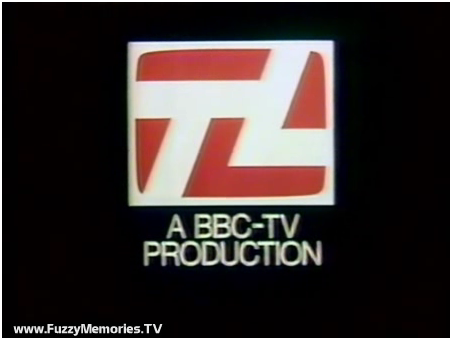
Here is the tail end of the Time Life edition of Python’s “The Golden Age of Ballooning,”
which I never knew until just now had been included in the Time Life package at any time.
Here you can see and hear the modernized Time Life logo that I swear I have never seen before in my life.
The web page from whence that clip derives, “Fuzzy Memories,” has a most interesting essay below the clip.
Here is a fascinating passage:
|
By 1980 the members of Monty Python were able to acquire the rights to the program from the BBC,
and pulled the show from distribution because it was “overexposed.”
Chicago Tribune TV-Radio critic Ron Alridge noted in his column at the time,
“The station’s rights to broadcast the British comedy expired,
and the distributor isn’t renewing rights, for any station, for next year.
The ‘Python’ shows will be
|
I was surprised to read at Wikipedia
of even further deletions in the “Summarize Proust”
and “Travel Agent” sketches.
That surprised me,
but Python expert David Morgan (who corrected numerous errors on this page for me) assures me that they were indeed cut,
even in the Time Life days.
Strangely, when Devillier Donegan had the license, the “Summarize Proust” sketch was complete,
with Graham Chapman naming all three of his hobbies, rather than just the first two.
And that’s exactly how I remember it, and that’s the only way I remember it.
Take a look at the complete sketch, which I understand is not available on home video anywhere:
So, whatever happened to the original tapes?
The story is vague, but reading between the lines, this is the narrative I have been able to piece together.
Time Life received PAL copies from the BBC, but could not afford to convert the masters to NTSC for US/Canadian broadcast.
Then in 1974
Dean Martin’s Comedy World,
a summertime replacement series, wished to license some clips.
I saw that episode, because I know that, sometime in 1974, I saw Monty Python clips on network television.
For some reason I misremembered that they were on Candid Camera,
but David Morgan assures me they were on
Dean Martin’s Comedy World.
Now why on earth would I have been watching that?
I was not at all a fan of Dean Martin (he seemed to be a nice guy personally,
and, given good material, he could be a wonderful performer,
but I didn’t and still don’t like smutty humor
and I have never found alcoholism amusing).
But just now, in Googling, I discovered that Dean Martin never appeared on this series.
He just licensed the use of his name.
This series was basically a compilation of comedy highlights from all over the place,
and it occasionally included clips from silent movies.
A ha! That’s why I watched it!
Anyway, I distinctly remember two and only two and no more than two Monty Python sketches that day, namely
the flasher
(“BOO!”) and
“The Dull Life of a City Stockbroker”
(minus the nude scene).
Wikipedia
mentions that a few of the Monty Python cartoons
also appeared on this episode, but I don’t recall that.
And CalMeacham on Straight Dope
claims she saw the
“Hell’s Grannies”
on that episode, which I don’t remember at all.
Further, Fafner on In the 00s
claims that episode also included the Dead Parrot
and Buying a Mattress.
Oh fiddlesticks! Those were included too? Really? Is my memory that bad?
(Chuck Rothman, commenting on IMDb,
remembers that Dean Martin’s Comedy World also included the cartoon of the Montgolfier brothers bathing themselves
with the words “naughty bits” deleted.
Before that explodes into another urban legend, rest assured that he’s confusing Dean Martin’s Comedy World
with ABC’s Wide World of Entertainment.)
David Morgan, renowned Pythonist, sent me an email explaining some background, and he granted me permission to quote him:
|
When Nancy Lewis was trying to sell the show in the States (in 1973 or even ’72),
she did have to bring prospective buyers to an office at
But the entire series was not transferred from PAL to NTSC until the sale to
Dean Martin’s Comedy World went through —
the purchase of rights to broadcast bits of MPFC on the summer series paid for the conversion of the entire run.
That made it much less expensive for buyers (PBS in this case) to take it on.
That conversion may have been done in the UK, I just don’t know, but it would have been in 1974, not before.
|
According to a recent posting
on the AMIA-L list serve,
these conversions were something new, significantly better than previous systems conversions.
Probably nothing mechanical was used in the conversion.
Everything seemed to have been done entirely electronically,
and people at the time were amazed at the high quality.
I, on the other hand, was never amazed, because by the time the shows reached my other home town of Albuquerque
(where I lived from July 1971 through October 1984)
the shows looked dreadful; they were the worst conversions I had ever seen.
I am sure that what we in Albuquerque were viewing was significantly degraded from the original conversions.
Time Life and PBS had no idea at all that the tapes in their possession were anything special.
When Time Life’s license expired, most or all the tapes in its possession were wiped or discarded.
Besides, by then they had all worn out.
Remember, back in those days, videotapes were quite fragile and could withstand only about five passes
before they were rendered unbroadcastable.
I remember that many of KNME’s broadcasts looked quite horrible
because their budget did not allow for the purchase of sufficient new tapes,
and so tapes were being wiped and re-recorded up to about 70 times!
Also, Time Life’s tapes did not have closed captioning, which made them useless for future broadcasts.
Nobody was interested in a broadcast tape that did not include closed captioning, and that would have been further incentive to dispose of the tapes.
Devillier Donegan’s tapes, on the other hand, did have closed captioning.
Nonetheless, there is some small hope of recovering the originals, though,
because of the peculiar method by which Time Life distributed Monty Python’s Flying Circus.
Normally, local affiliates would record satellite transmissions for later broadcast.
In this case, though, NTSC conversions on 2" quad or ¾" U-Matic were packed up and shipped to each local affiliate,
without any guarantee.
That is why one autumn Albuquerque station KNME found itself unable to broadcast the scheduled series, for the provider had shipped over defective tapes,
for which there would be no replacements or refund.
So, from 1974 through 1979, there was an unusually large number of tapes of all these episodes,
and so there’s a small chance that a few forgotten tapes are still collecting dust in some TV stations’ corners somewhere.
A very small chance, David Morgan assures me, because he has scoured the stations already, to no avail.
Nonetheless, I still hold onto some hope that a technician charged with discarding used tapes decided to souvenir them instead.
Precisely two Time Life 2" quads were kept on file at the Library of Congress,
but unfortunately, those were not the episodes we’ve been seeking.
So now you know.
That is why we are on the hunt for the Time Life editions.
So write to me if you’ve got them in your collection somewhere.
Thanks!
Oh! Just discovered some more missing sketches, stuff that’s all new to me.
I had heard vaguely of the wine-tasting sketch, but not of the others.
I guarantee you’ve never seen these on any broadcast:
Lost Sketches.
Now, you never knew about all that, did you?
My heaven how I hope that tape turns up somewhere!
Isn’t it comforting to know that the censors are protecting us?
Does anybody remember Monty Python Meets Beyond the Fringe?
I really liked it, though almost nobody else in town could be bothered.
The cinema was nearly empty.
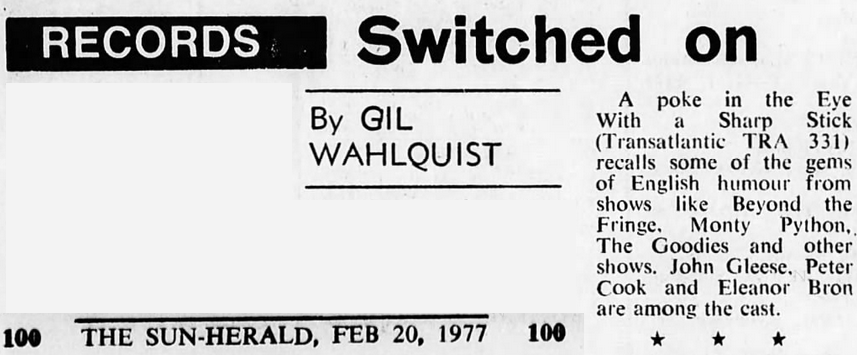
The Sydney Sun-Herald, Sunday, 20 February 1977, p. 100
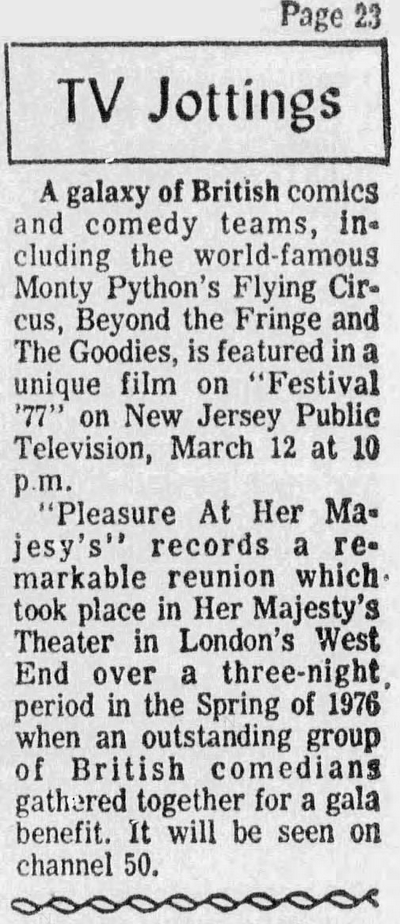
The Ridgewood Post, Wednesday, 23 February 1977, p. 23
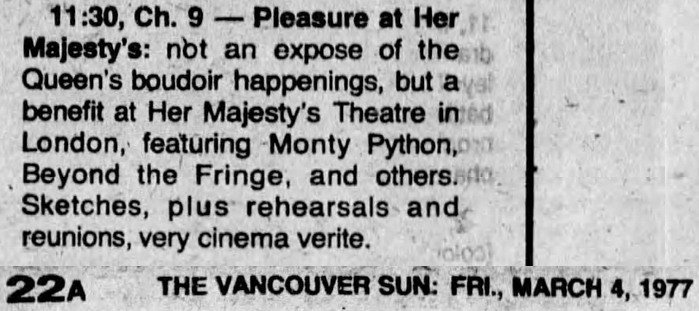
The Vancouver Sun, Friday, 4 March 1977, p. 22A
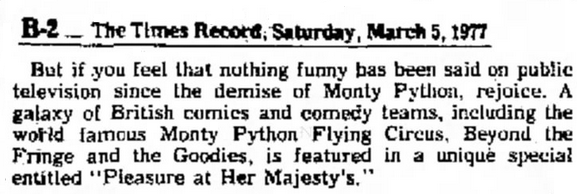
The Troy Times Record, Saturday, 5 March 1977, p. B-2
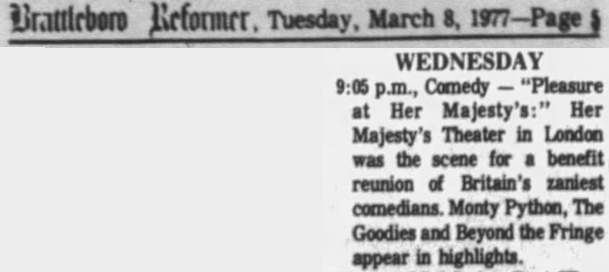
So, could somebody fill me in?
I saw this movie on Saturday, 15 July 1978, at the
Lobo in Albuquerque, cropped to 1:1.85, predictably.
I had not known that this film had already been shown on
PBS from March through December 1977.
The PBS showing was cut to one hour.
What we saw at the cinema was a bit more generous, but most definitely not complete —
according to IMDb, it was 85 minutes,
though I’m not sure that’s right.
The version currently on YouTube is 20 minutes longer,
and even that is obviously incomplete.
The version I saw at the Lobo opened with, I think, a momentary shot of a street with Her Majesty’s Theatre in the center of the frame,
and a narrator announcing “...Pleasure at Her Majesty’s Theatre, where Monty Python Meets Beyond the Fringe...,” or something like that.
I never knew about the opening 34 minutes of behind-the-scenes.
There was no such thing on screen when I saw it.
Instead of behind-the-scenes, there were some short subjects —
two, if memory serves, and those were also cropped to insensibility at 1:1.85.
My memory of those shorts is almost nonexistent, except that I recall finding them juvenile rather than amusing.
I remember a guy on a street, wearing a chicken costume, being interviewed on camera for a news show, speaking only in clucks.
At the very bottom of the screen we could see the tops of the subtitles, but not enough to make them out.
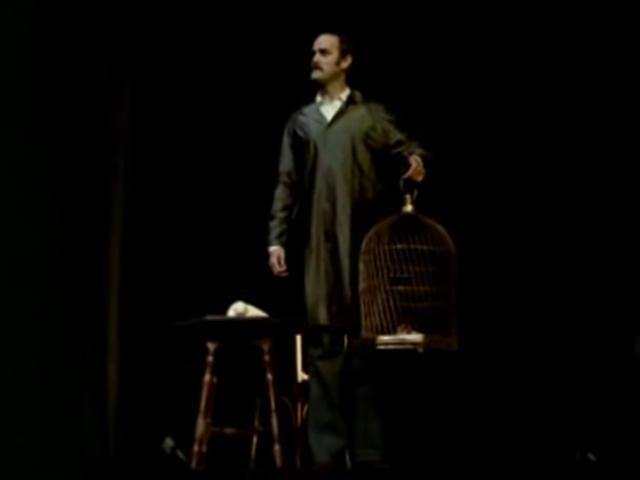 |
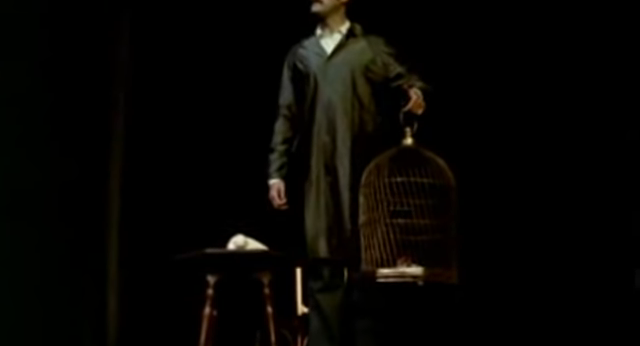 |
| Proper presentation (Academy 1:1.375, projector aperture .600"×.825") |
As cropped at modern American cinemas (US widescreen 1:1.85, projector aperture .446"×.825") |
After the show, I trudged up to the Lobo’s projection booth.
Of course, visiting the booth was against union rules and in violation of insurance policies.
Why the staff allowed me to do that, I do not know, but they did.
When the program started again, I adjusted the framing to see what the subtitles were.
I should have guessed: “Cluck cluck cluck cluck cluck....”
I had met the projectionist before, and he was not the brightest.
Remember, this was Albuquerque.
There was not a cinema anywhere in the city that got good results on screen.
The maintenance guy for all the Commonwealth cinemas, whose name escapes me and whom I never met, was magnificent.
With him visiting each booth regularly, I must admit that the machines were immaculately clean,
perfectly lubricated, quiet, and in excellent running order, and the wiring was so professional as to be invisible.
I wish I had that guy’s knowledge and skill.
Even so, there was one element that was beyond his capacity to repair: the human element.
There was always something wrong — always!
Sometimes it was poor sound, sometimes it was motorboating when the sound reader was out of alignment and read picture or sprocket holes,
sometimes it was uneven light, sometimes it was poor focus, often it was misframes, often it was distortion caused by off-center booths,
sometimes it was sound half a second ahead of the picture
(courtesy of those rotten Imperial console projectors that badly ripped off the Cinemeccanica Victoria 8),
almost always it was unforgivable cropping, and the list goes on.
Nearly every projectionist deliberately vandalized the films,
literally chopping three or four feet from the beginning and ending of each reel and tossing them into the rubbish bin —
not because the footage was damaged, but just for the heck of it.
I saw that happen so many times that I could barely restrain myself from committing murder.
The cinemas that still ran on single reels sought to avoid showing leaders and tails on screen
by cueing so far in that they would skip five or ten seconds at each reel change.
Almost no projectionist was aware of formats other than “flat” and “scope,”
and whenever I tried to explain that there were plenty of others,
I would be laughed out of the building.
Anyway, I asked the Lobo’s projectionist why he was running the film at 1:1.85 rather than 1:1.375.
After all, he had the apertures and lenses for the other formats readily available in his lens cabinets.
His response: “I tried those lenses once and I don’t know what they’re for; they just made the picture too small.”
I explained that those lenses were meant to be paired with different aperture plates,
but he got confused, shook his head, and said “No.”
I asked if he had noticed that the top and bottom of the image were severely cropped on screen.
His response, which I remember verbatim: “That’s because it’s a sh__y movie.”
My memory is vague now, and I do not recall if Monty Python Meets Beyond the Fringe
looked as though it had originated on 35mm or 16mm,
though according to DVD Talk,
it was indeed shot on 16mm, which would help explain the framing issue.
As for the follow-up films, The Secret Policeman’s Ball and The Secret Policeman’s Other Ball
were not shown in their entirety in the US.
What we got instead was highlights from the first immediately followed by highlights from the second, jammed together into a single film,
each half opening with its original title, though the poster used the title only of the second film.
My memory is that they had been shot in 35mm, with the cameras buried down in the orchestra pit.
When US cinemas presented this abridgment, the cropping was almost unbearable.
They were definitely framed for widescreen, though, probably a tight 1:1.66.
Funny movies, despite the cutting and cropping, and Peter Cook was simply glorious.
Occasionally, through the decades, I have thought again about Monty Python Meets Beyond the Fringe and hoped to see it again.
I had not realized it was on VHS and later on DVD.
I just now found it!
Currently it is much longer, 105 minutes, but without the short subjects.
What were those short subjects?
I would love to see them again, not because I had any fondness for them, but only because I am curious.
I checked newspaper listings from 1977 through 1979 to see if there was any mention of them.
Nope.
The few reviews ignored the shorts,
and the
poster and the newspaper advertisements didn’t even hint at them —
and didn’t even name the distributor!
According to IMDb, though,
it was New Line Cinema that distributed the movie in the US,
premièring it in Austin in 1977.
(New Line was mentioned in an ad in Tampa, but nowhere else that I can find.)
The posters did, though, reveal that, in the US at least, the 1977 copyright was claimed by Staple Films, whatever that is/was.
In checking the newspapers, I see that when the movie opened in Boston,
it was accompanied by two short films, Thank You Mask Man and
Captain Silas (thanks to a reader who identified that latter film for me!),
but these were definitely not the ones that accompanied the feature in Albuquerque.
I know Thank You Mask Man
as well as Bambi Meets Godzilla from their having been welded to
The King of Hearts.
When the feature showed in Petaluma,
it was accompanied by the Firesign Theatre’s Martian Space Party,
which is definitely not what I saw in Albuquerque.
When it played in St. Louis, the accompanying short was a Three Stooges cartoon.
This is odd.
Normally, in the 1970’s, if a feature was shown with shorts, it was shown with those same shorts at every booking.
I don’t understand what happened with these bookings.
Here is something I understand even less:
The print shown in Tampa retained the
behind-the-scenes material,
which took up half the running time!
How many versions of this movie were issued?
Why?
Oddly, the print shown in Tallahassee was just over 75 minutes.
Typically, the Tallahassee critic’s knowledge of the technical side of movies,
even the most basic knowledge, was entirely wanting:
“The camera work is so terrible that actors’ heads are frequently cut out of the frame....”
No, that was not terrible camera work; that was terrible projection.
The camera work was adequate, given the constrictions of shooting a live performance in a nineteenth-century theatre.
What’s more, the version currently posted on
YouTube deletes the middle of the miner’s sketch.
I thought I had seen the entire sketch.
I swore I had seen the entire sketch.
Now that I think about it, though, no, no way, I had not seen the entire sketch.
The middle was missing when I saw it, but without the cutaways to the dressing rooms.
That was my favorite part of the movie.
It would be nice if somebody, somewhere, sometime, would rummage through all the old prints and materials and piece this thing back together properly.
Reviews:

Austin Daily Texan, Tuesday, 6 September 1977, Images section, p. 19.
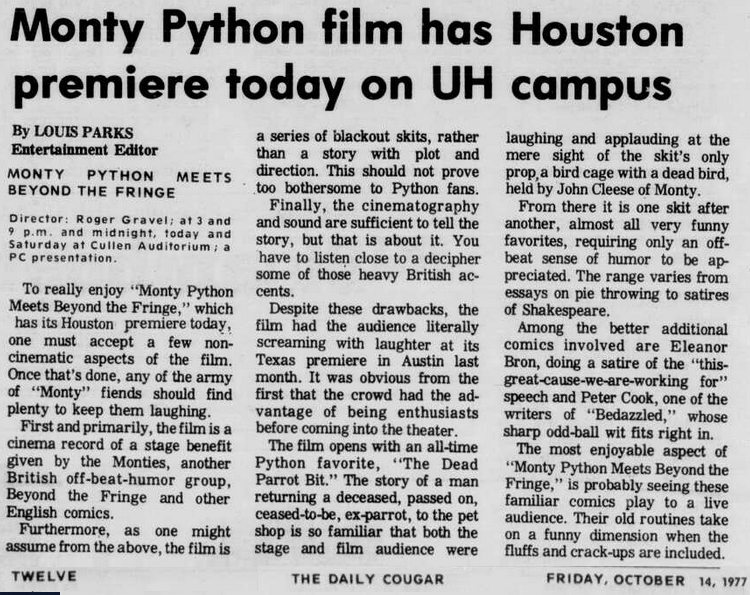
The [Houston] Daily Cougar, Friday, 14 October 1977, p. 12.

The Manhattan [Kansas] Mercury, Wednesday, 25 January 1978, p. C6.
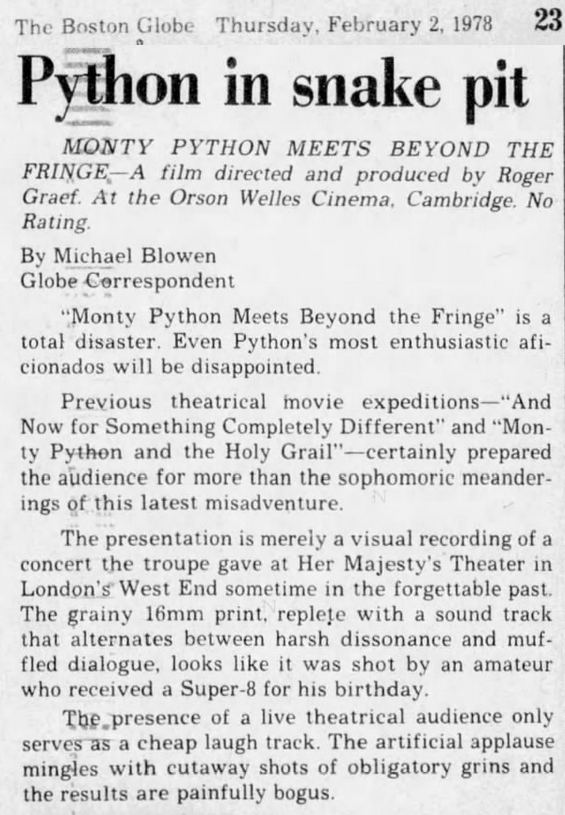
The Boston Globe, Thursday, 2 February 1978, p. 23.
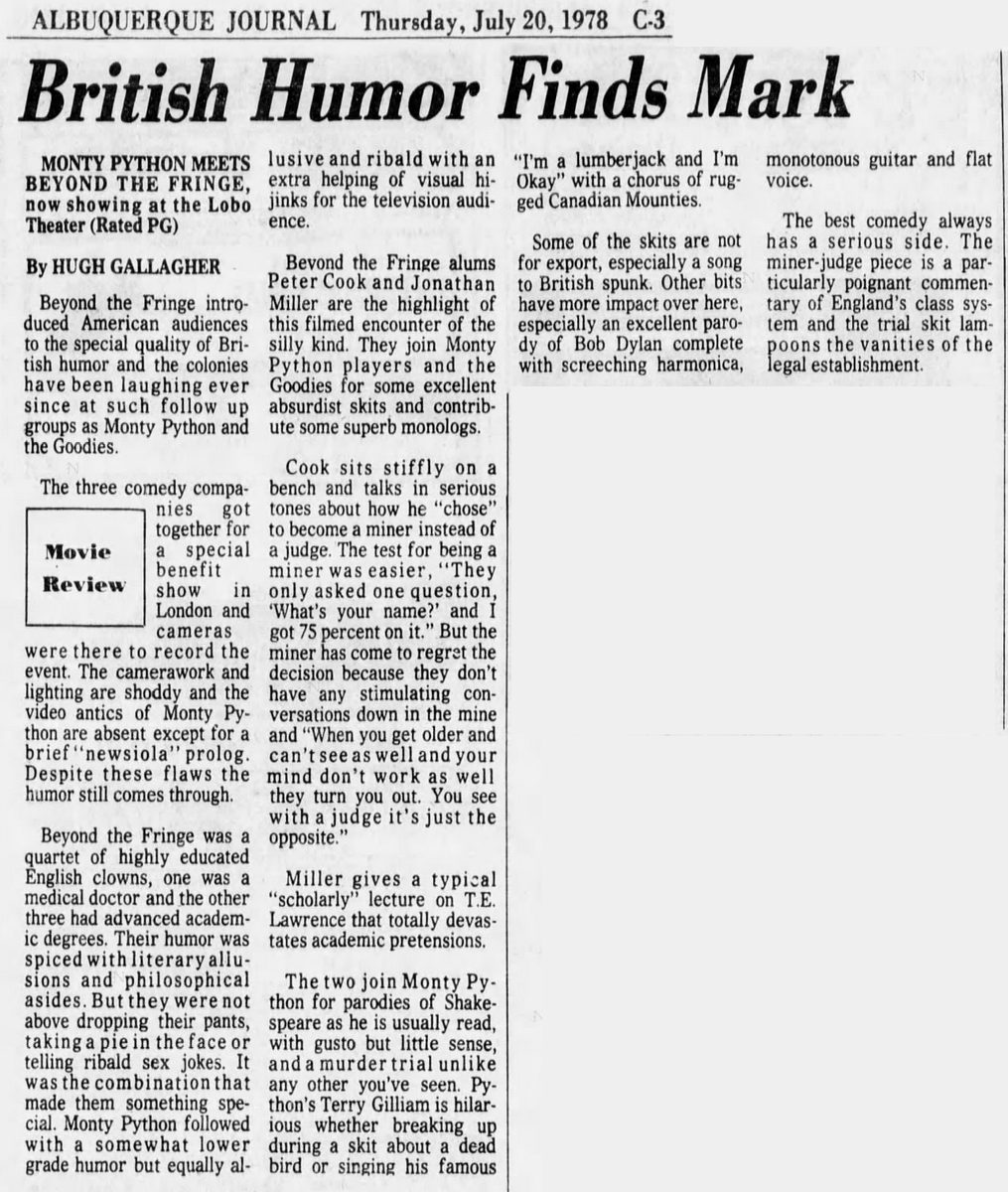
Albuquerque Journal, Thursday, 20 July 1978, p. C-3.
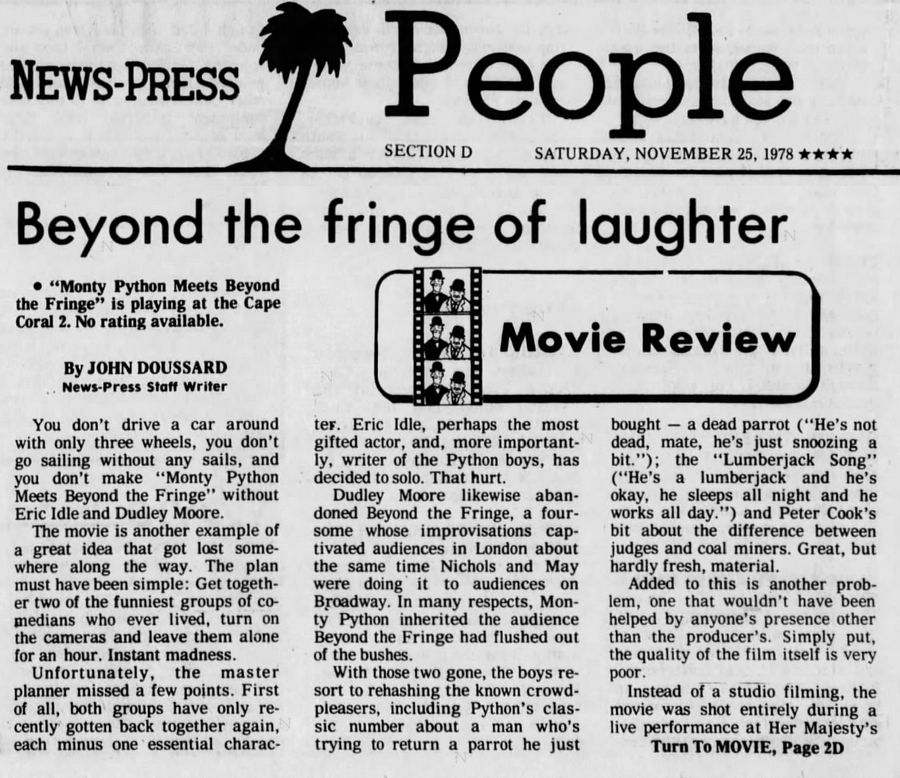

The Fort Myers News-Press, Saturday, 25 November 1978, pp. 1D, 2D.
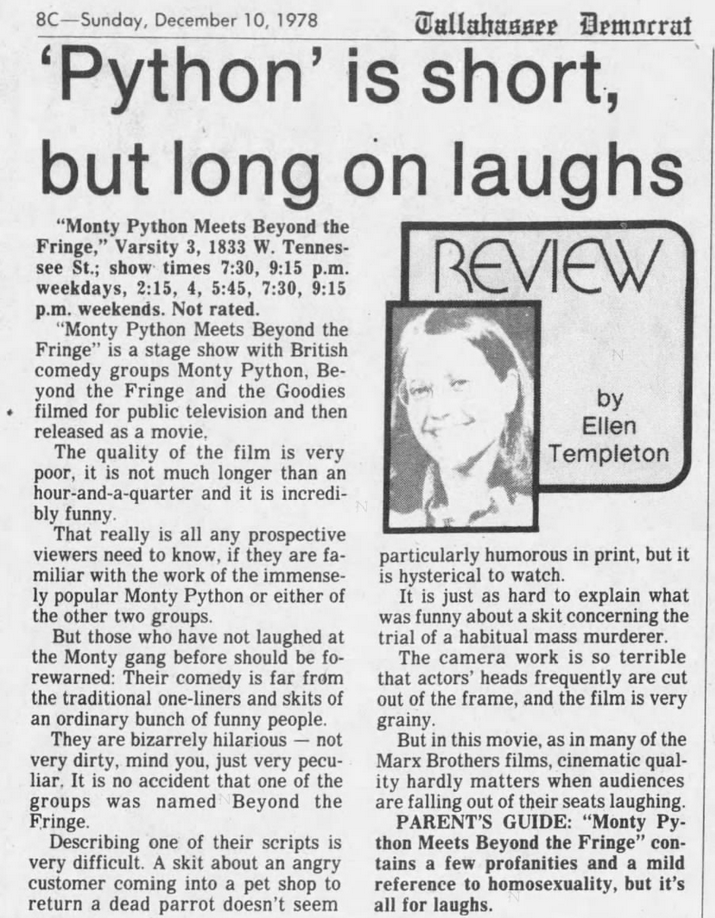
The Tallahassee Democrat, Sunday, 10 December 1978, p. 8C.
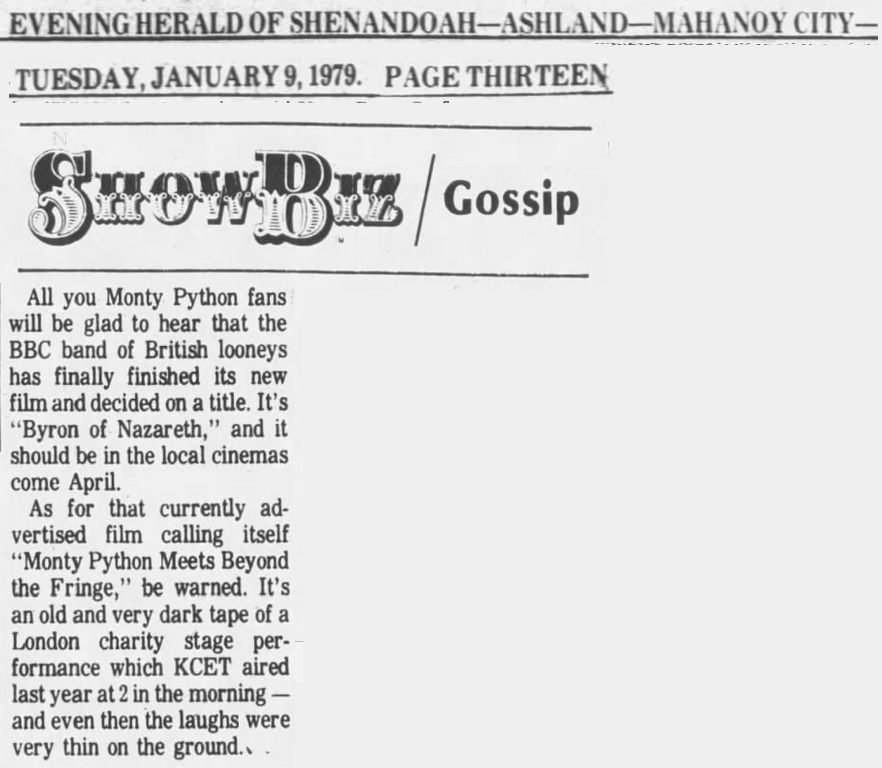
Evening Herald of Shenandoah, Tuesday, 9 January 1979, p. 13.

Detroit Free Press, Friday, 12 January 1979, p. B1.
As you can see, some of the review were vicious.
True, Monty Python Meets Beyond the Fringe was poorly shot and poorly miked,
which was inevitable considering the suboptimal conditions under which the crew were working.
There was no place to put the cameras, actually, and so they were stuffed into whatever corners the crew could find.
The actors did not have microphones, which is why they spoke loudly.
Where did the film crew place their microphones?
I don’t know.
Wherever they could fit, I guess.
Is this good cinema?
Not at all.
Is it entertaining?
That’s a matter of opinion.
Some people found it a big glob of nothing, and were offended that this “film” was actually a stage presentation, not a proper movie.
On the other hand, I was laughing harder than I had in years.
Is the movie worth the trouble?
Absolutely!
Imagine how frustrated we would all feel if this show had not been recorded at all.
The movie is a solid record of a solid performance, and is of value for historical reasons, if nothing else.
For me, it is a treasure.
Does anybody have information on the US cinema release, or on the various cuts, or on the whereabouts of the master footage?
If you want more information on Albuquerque cinemas,
information that you won’t find anywhere else, click here.
information that you won’t find anywhere else, click here.
#30#
Text: Copyright © 2019, Ranjit Sandhu.
Images: Various copyrights, but reproduction here should qualify as fair use.
If you own any of these images, please contact me.
Images: Various copyrights, but reproduction here should qualify as fair use.
If you own any of these images, please contact me.
